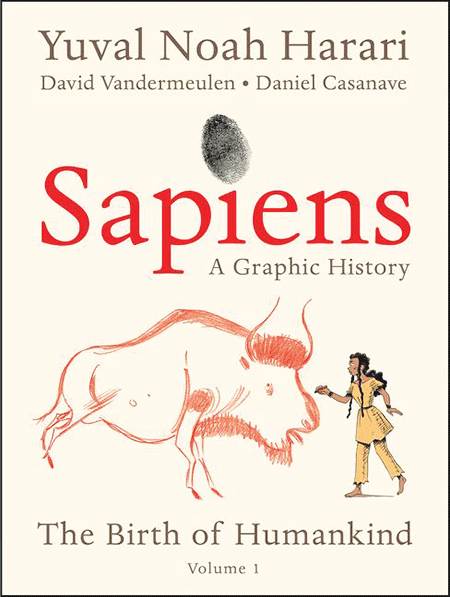Sapiens: A Graphic History: The Birth of Humankind (Vol. 1), by Yuval Noah Harari, David Vandermeulen and Daniel Casanave, Harper Perennial, paperback, 245 pages, $25.99
Reviewed by NEAL GENDLER
Midway through Sapiens: A Graphic History, I realized why this illustrated, entertaining adaptation of Yuval Noah Harari’s huge-selling Sapiens: A Brief History of Humankind is so worthwhile.
It’s brilliant.
That’s quite a surprise to a reviewer who’s often scorned “graphic novels” as comic books for people too lazy or unimaginative for grown-up reading.

The original Sapiens has sold 16 million copies in 60 languages. Harari, a historian, philosopher and Hebrew University lecturer, has an ambitious goal here: explaining Homo sapiens’ “cognitive revolution” and development in a lively, humorous way — one appealing, instructive and entertaining for both youngsters and adults.
David Vandermeulen and Daniel Casanave are credited with the idea for this format and text adaptation. Casanave’s illustrations were colored by Claire Champion, who seems particularly fond of shades of orange and tan.
The result is quite charming. Harari appears as himself: slender, balding, bespectacled Yuval, explaining to niece Zoe that Homo sapiens — us — is just one of several lines of humans. We outlasted, among others, Denisovans and Neanderthals, although evidence suggests some Neanderthal-Sapiens interbreeding.
Zoe accompanies Yuval through the first part of the journey, aided by Prof. Arya Saraswat’i, a matronly biologist with a bindi — red dot — on her forehead. As we go along, we’re joined by two other women, anthropologist Aiko Yoshita; Brazilian anthropologist and geographer Dr. Duarte; and priest-archeologist Dr. Father Klüg (klug, minus umlauts, means “smart” in Yiddish).
They seek to answer what Harari’s website calls “a niggling question: How on Earth did an insignificant ape become the ruler of the planet, capable of splitting the atom, flying to the Moon, and manipulating the genetic code of life?”
The answer is a “cognitive revolution” 70,000 years ago leading to humans’ ability to cooperate, shown in a tone of lighthearted amazement that pervades the book while imparting serious information — sometimes pretending to be a TV show, panel discussion or comic book.
This Sapiens version leaps from the Big Bang to the emergence of humans, with a good deal of attention to hunter-gatherers, praised for healthy, varied diets that required only four to six hours of daily work. This is contrasted with the often limited diet of the agricultural age and the later-ages crowding in cities, conducive to spread of disease.
Mid-book, in flies red-caped, green-tights-clad Dr. Fiction, a Black woman with superpowers and an apparent virtual-reality device over her eyes. She argues the power of myth, suggesting religion is a widely accepted myth that comes with rules of behavior.
It would be a shame if “myth” and “insignificant ape” cause literalist believers to ban this joyfully educational book.
Unexpectedly, Fiction takes us into an explanation of the limited liability company, teaching early automaker Armand Peugeot its protective advantages and telling the rest of us that corporations are a “legal fiction” created from words, “an imagined reality,” which might surprise some Supreme Court justices.
Harari’s lessons seem packaged to pass American correctness tests. All people are sapiens — which means “wise” — and they appear in many skin shades and varieties of attire, even a little nakedness. Women are prominent experts, illustrations show at least two gay couples, and a man insisting that all families include father, mother and children gets a gently delivered instructional slapdown.
Perhaps unrecognized by younger characters, historical figures appear unremarked: Charlie Chaplin, Albert Einstein, Vladimir Lenin, Karl Marx, Benjamin Franklin and others. An “American Gothic” frame shows a Neanderthal as the husband.
A few unobtrusive kipa-wearing men and one “Jewish rabbi” (there’s another kind?) in a timeline of theist characters seem to be the only things overtly Jewish. A two-page, 13.8-billion-year timeline at the book’s beginning includes millennia for the start of polytheistic religions, Buddism, Christianity and Islam, but not Judaism; perhaps too imprecise?
The last section features a police caricature, Detective Lopez, who has traded lip-dangling cigarettes for a licorice stick and, oddly for a detective, wears a uniform. She has arrested two primitive sapiens, suspects as “the worst serial killers of all time.”
To make her case, she gives an overly long ecological lecture and world-circling flight to Yuval, Saraswat’i and the humans’ unkempt attorney: orange-haired, hook-nosed Adamski.
I don’t think I’m giving away a surprise by revealing that the subsequent trial, a long summary of the extinctions caused by sapiens, convicts us all.
***
Neal Gendler is a Minneapolis writer and editor.



















